How to charge your smartphone for half an hour and not turn it into a Galaxy Note 7
Hi, Geektimes! Some of them are now working in the office, others drink tea (or something stronger) at home, and some still freelance from fabulous Bali, give them a frosty Moscow hello. But wherever you are, one thing remains unchanged - you need to charge your smartphone every day, if you have, of course, no Nokia 3110 or a beast for 10,000 mAh. And since manufacturers of mobile devices are confronted with the fact, I would like to make this procedure as fast as possible, for this, smartphones are equipped with support for Quick Charge and other similar technologies. And while your iPhone is slowly charging, trying to gain the coveted interest, you are welcome under the cat.
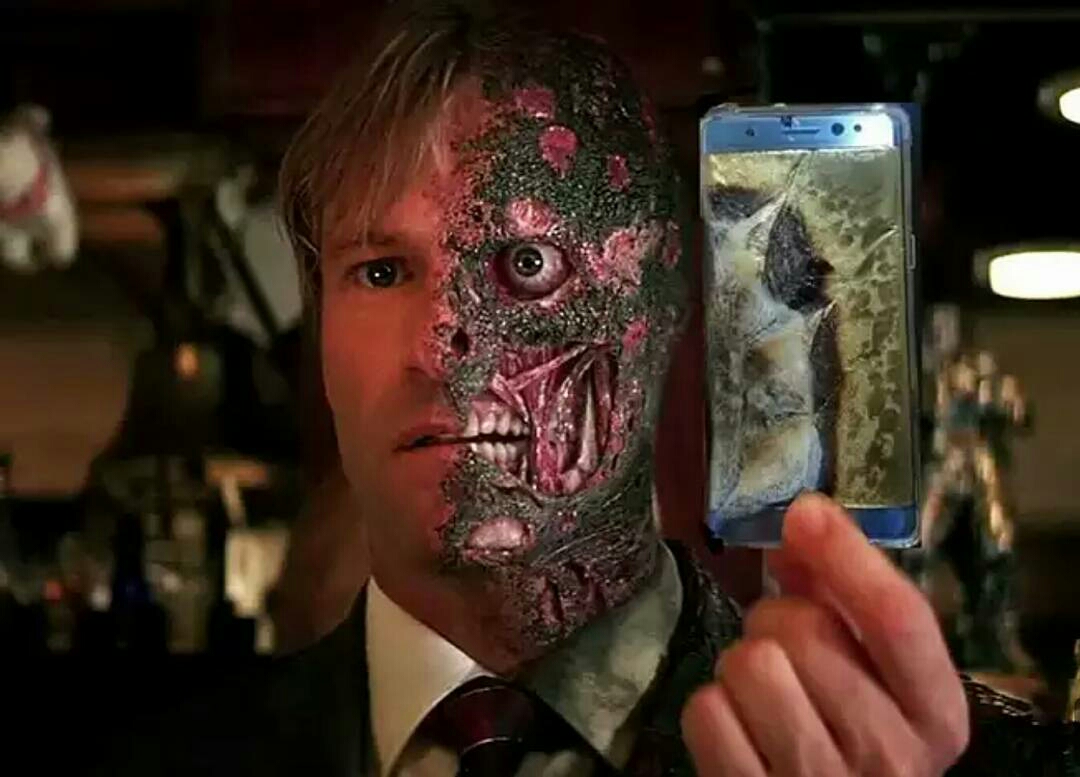
Charging a smartphone is a painful question for many. It is not surprising, because if the device battery is weak, and it is used almost to the maximum, it will have to be connected to the charging (or external battery) more than once a day. How cool would it be to take a smartphone with a battery, for example, at 2,750 mAh and charge it from 0% to 80% in just 30-35 minutes? When in the normal mode only the fifth part comes up during this time, it sounds fantastic. Qualcomm, which has been releasing Quick Charge-compatible chips for several years, made this a reality.
Now the fourth generation of this technology is presented, and it all began in the near 2013, when more than 70 mobile devices received support for Quick Charge 1.0. Then it seemed incredible that a smartphone could just as easily take and charge four times faster than usual. A year later, the developers accelerated and together with the Snapdragon 800 processor introduced the second generation of technology that could accelerate battery charging up to 75%.
')
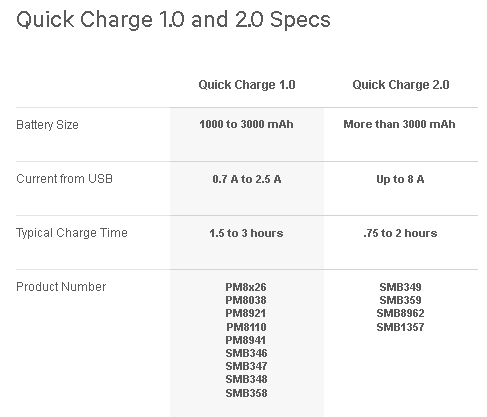
The numbers from marketers are, of course, great, but how does such an increase in charge rate come about?
As you know, each smartphone or tablet is designed for a specific current and voltage. Therefore, to charge it, letting a greater current, will not work. QC adapters allow the device to take more voltage and current, thereby ensuring faster charging of the device.
The basis of any battery is an electrochemical process, through which the accumulation and return of energy. When charging a lithium-ion battery, the following reactions occur.
On positive plates:
On negative plates:
When a discharge occurs, the back reaction takes place accordingly.
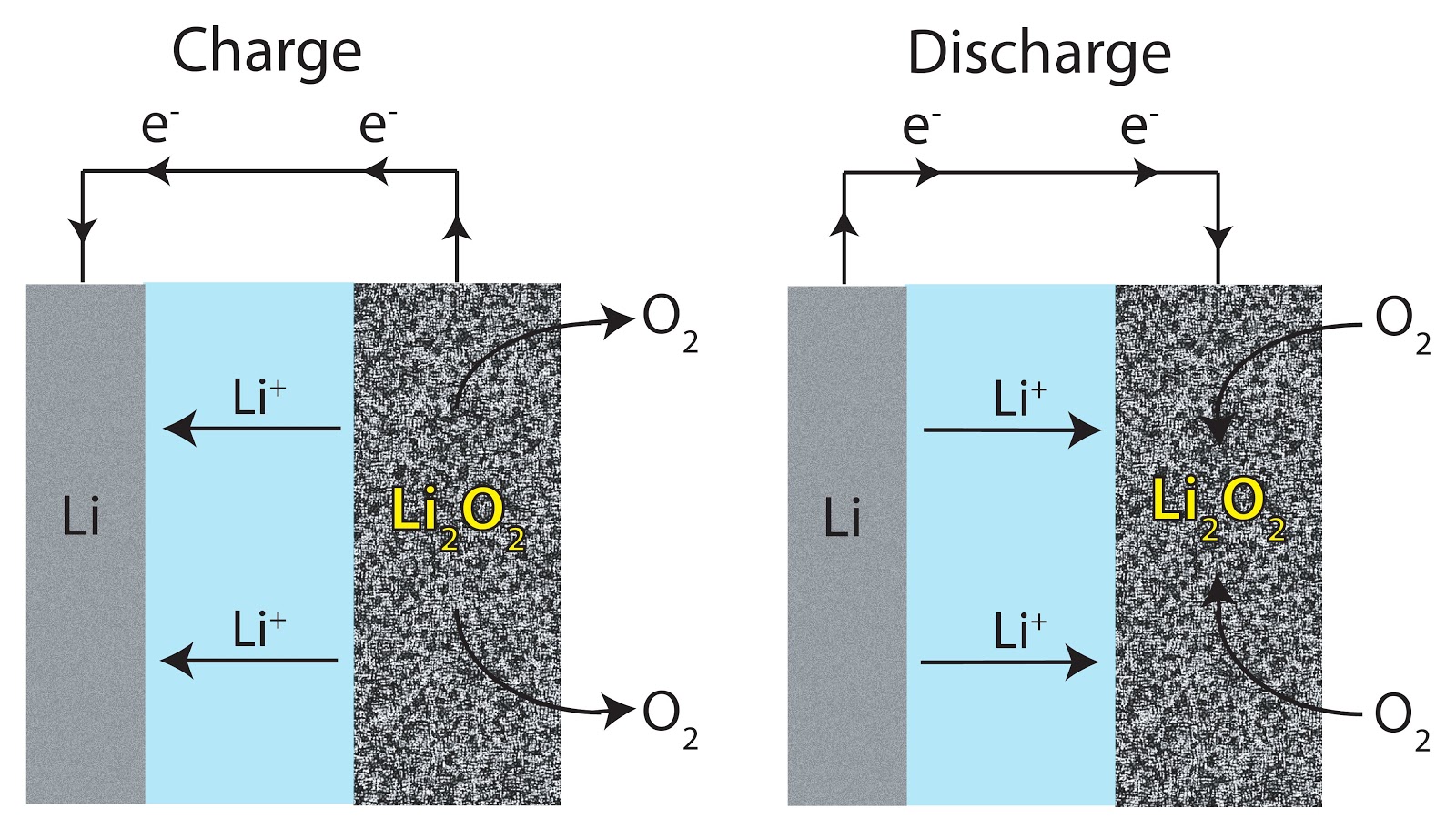
Lead, nickel, and lithium were used as chemical sources at the time. Nowadays, batteries based on the latter (lithium-ion (Li-ion) and lithium-polymer (Li-pol) are mainly used in mobile devices. They have low self-discharge, a good supply of capacity, no memory effect, but over time they lose capacity and can be explosive - the case with Samsung's Galaxy Note 7 is too much evidence of this.

Implications of using Galaxy Note 7
Modern lithium-ion batteries can be either 1,500 mAh or 9,000 mAh in capacity, depending on how much the manufacturer is willing to sacrifice the dimensions of the device. The nominal voltage of such a battery is 3.5–3.7 V, and the maximum reaches 4.2 V. The process of charging the battery itself can be divided into two stages: first, there is a process of fast charging with a high power current until the voltage reaches a threshold value. Then, as soon as the maximum voltage on the battery is reached, the charge current decreases until the battery is fully charged. Charge termination occurs if the charge current decreases to 3% of the initial value. A special controller is responsible for the lack of recharge battery.
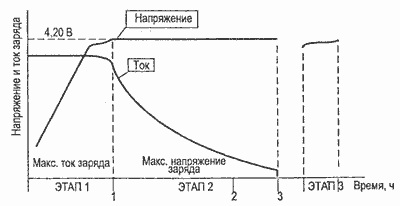
There is a third stage - when the charge is periodically compensated, approximately every 500 hours of storage. If the lithium-ion battery is fully charged in 1 hour or in less time, the battery enters the ready state after the first stage is completed, the second stage is excluded in this case.
The essence of fast charging is to transfer the maximum possible current from the charger at the first stage of charging so that the chip in the smartphone can process it. Qualcomm developed the technology gradually: Quick Charge 1.0 was charging with 5V / 2A output characteristics, the whole process was carried out up to 40% faster. The technology was supported by Nexus 4, LG Optimus G, Samsung Galaxy S III and many others.
The second generation of technology was not long in coming: here we already have 3A and 5V / 9V / 12V. Qualcomm's laboratories achieved impressive results - when charging a battery with a capacity of 3,300 mAh for half an hour using Quick Charge 1.0, the charge level was 30%, and in the case of Quick Charge 2.0 - 60%! At the same time from the usual charging 5V / 1A battery could charge only 12%. Support for the second generation of QC received smartphones such as the Nexus 6, Samsung Galaxy Note Edge, Samsung Galaxy Note 4, HTC Desire EYE, Blackview R7 4G and many others.
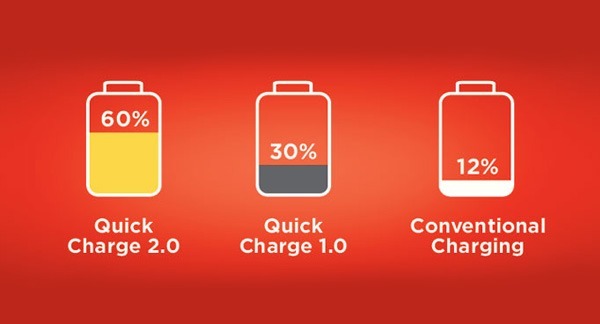
It would seem that there is nowhere to strive for, but Quick Charge 3.0 appears on the scene, which is used by most manufacturers of modern smartphones - from Xiaomi Mi5 and Mi Mix to AGM X1 4G and Lenovo ZUK Z2 ($ 178.99 on coupon ZUKS ). It has not been without significant innovations in the form of support for INOV, the technology of intelligent voltage selection, which also accelerates the charge replenishment. The voltage is individually selected for each device and can vary from 3.2 volts to 20 volts (change step - 0.2V). QC 3.0 debuted with Snapdragon 820, 620, 618, 617, and 430 processors and received USB Type-C support.

But the current history of Quick Charge does not end there (yes, the new Qualcomm standard represents more often than Apple presents the iPhone). In the fall of 2016, the company announced a new Snapdragon 835 chip and Quick Charge version 4.0. The processor is made with a 10-nanometer process, which improves not only the performance of the chip, but also its energy efficiency in comparison with the same Snapdragon 820 and 821, which uses a 14-nanometer process. Obviously, the 835 will find its place among the new products of the smartphone market in 2017, but we are more interested in the fourth generation of Quick Charge. According to representatives of Qualcomm, the technology allows in just five minutes to charge the smartphone so that it is enough for five hours of operation of the device.
Half charge a smartphone with a 2750 mAh battery with QC 4.0 will dial in just 15 minutes. Check the accuracy of this statement is now possible except in Qualcomm laboratories, since smartphones with support for this technology are not yet on the market. Pleasant power-ups include full USB Power Delivery compatibility and the third version of the smart voltage optimization INOV. The voltage for a particular device is determined automatically and the optimum is chosen depending on the temperature conditions. In this case, the power adapter and the device itself will have four-level protection against overheating and overvoltage. To achieve maximum performance, new SMB1380 and SMB1381 power controllers have been developed with maximum efficiency up to 95%.

For now, Quick Charge 4.0 raises more questions than answers. However, this year, Qualcomm promised to reveal the details of the technology.
Yes, fast charging technologies are used by others, and this is not Quick Charge. For example, many smartphones use TurboCharge, FastCharge, and others, which essentially work on the same principle as the Qualcomm standard.
Since not all devices run on Qualcomm processors, it would be strange if smartphones with other chips were cheated by fast charging. This is primarily, of course, about Mediatek and its Pump Express technology. Last year, the company introduced the standard version number 3.0: charging from 0% to 70% for 20 minutes (depending on battery capacity), a five-minute charge is enough for four (!) Hours of operation in voice mode. In fact, the fastest charging smartphone in the world.

Overheat protection and USB-C support. When charging, the standard internal circuit is not affected, the current goes directly from the adapter to the battery. Compared to version 2.0, Mediatek did a tremendous job, focusing on energy leaks - they were reduced by 70%.
The new technology will be available to devices running on the MediaTek Helio P20 chip - the first smartphones with this processor will be available later this year. Then we’ll check to see if Pump Express 3.0 is the fastest charging in the world, or marketers sang us again.
Separate attention deserves the company OPPO with its technology VOOC Flash Charging. Charging is performed with a current of 4.5 A and a voltage of 5 V using a special eight-contact battery. The current is evenly distributed between the cells into which the battery is divided, which supposedly reduces battery wear. One of the smartphones with support for VOOC Flash Charge is the OPPO R7 4G . According to the manufacturer, five minutes of charging will be enough for two hours of smartphone operation from the battery in talk mode (which is a lot). For example, Redmi 4 4G (according to Xiaomi's assurances and user experience), which runs on Snapdragon 625 and is much cheaper than its counterparts, is quickly charging, and with the XMMGB promotional code, it is available for $ 154.99 .

First, in the case of the Galaxy Note 7, most likely, there was a marriage of the batteries themselves, as well as their charging using non-original adapters, fast charging has nothing to do with it. As for its harm to the battery, this question is still open.
In 2014, Californian scientists found out that with a uniform charge of the battery, it can be used longer, although you’ve called a new discovery, we all went to lectures. It was decided to test the theory on existing batteries (manufactured from 2014), including charge / discharge cycles with a minimum current. It will take about 400-500 days to get results for extrapolation, or even more, so scientists have not yet provided the results of their research.
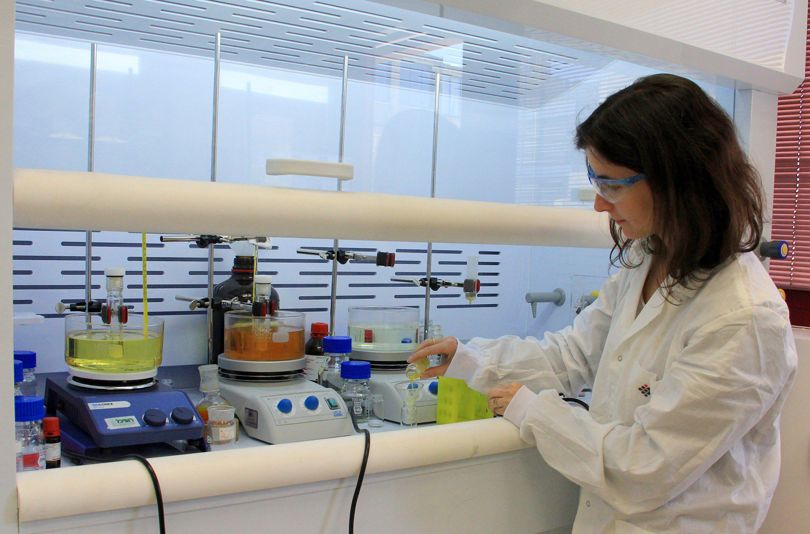
The issue was also discussed in mid-2015 on Reddit, then it was argued that due to fast charging, the lithium-ion battery overheats, and in the battery itself there are damaged areas that are unsuitable for subsequent charge / discharge cycles. This statement has not yet been scientifically proven.
Now scientists rely on existing Li-ion tests and agree that the battery life in the constant fast charging mode is falling. If you charge your smartphone quickly from time to time - the consequences for the battery will be insignificant. However, the producers themselves do not agree with this.
Qualcomm certifies a variety of accessory manufacturers that enable fast charging of devices. For example, the Xiaomi 10,000 mAh external battery has a port with support for Quick Charge 2.0.

Those who appreciate small portable solutions will like the YOUWAY charger - two 2.4A ports and one with Quick Charge 3.0 support. In smart charge mode it is 5V 7.8A, in QC mode it is 9V 2A or 12V 1.5A.

One device with Quick Charge 2.0 can be placed in the machine , it won't be superfluous. By the way, there are FM transmitters of the same form factor - without Quick Charge, though (5V / 2.4A), but more functional with Bluetooth. For a discount do not forget the coupon KHJA .

In general, solutions with support for QC weight - from compact and portable to stationary , which can be easily placed on a bedside table or office desk. Here the main thing to look at is that your smartphone supports the same version of Quick Charge.
Of course, you should not abuse fast charging, but it is also silly not to use the latest technological advances in this field. And you can be completely sure that nothing will burn and explode if you charge your smartphone faster. In fact, many people constantly charge their devices with Quick Charge, and after a while the battery is so slightly different from the state of the battery, charged in the usual way, that they don’t notice it.

Is there a charge? And if you find?
Charging a smartphone is a painful question for many. It is not surprising, because if the device battery is weak, and it is used almost to the maximum, it will have to be connected to the charging (or external battery) more than once a day. How cool would it be to take a smartphone with a battery, for example, at 2,750 mAh and charge it from 0% to 80% in just 30-35 minutes? When in the normal mode only the fifth part comes up during this time, it sounds fantastic. Qualcomm, which has been releasing Quick Charge-compatible chips for several years, made this a reality.
Now the fourth generation of this technology is presented, and it all began in the near 2013, when more than 70 mobile devices received support for Quick Charge 1.0. Then it seemed incredible that a smartphone could just as easily take and charge four times faster than usual. A year later, the developers accelerated and together with the Snapdragon 800 processor introduced the second generation of technology that could accelerate battery charging up to 75%.
')

The numbers from marketers are, of course, great, but how does such an increase in charge rate come about?
How Quick Charge Works
As you know, each smartphone or tablet is designed for a specific current and voltage. Therefore, to charge it, letting a greater current, will not work. QC adapters allow the device to take more voltage and current, thereby ensuring faster charging of the device.
The basis of any battery is an electrochemical process, through which the accumulation and return of energy. When charging a lithium-ion battery, the following reactions occur.
On positive plates:
LiCoO 2 → Li 1-x CoO 2 + xLi + + xe -
On negative plates:
+ xLi + + xe - → CLi x
When a discharge occurs, the back reaction takes place accordingly.

Lead, nickel, and lithium were used as chemical sources at the time. Nowadays, batteries based on the latter (lithium-ion (Li-ion) and lithium-polymer (Li-pol) are mainly used in mobile devices. They have low self-discharge, a good supply of capacity, no memory effect, but over time they lose capacity and can be explosive - the case with Samsung's Galaxy Note 7 is too much evidence of this.

Implications of using Galaxy Note 7
Modern lithium-ion batteries can be either 1,500 mAh or 9,000 mAh in capacity, depending on how much the manufacturer is willing to sacrifice the dimensions of the device. The nominal voltage of such a battery is 3.5–3.7 V, and the maximum reaches 4.2 V. The process of charging the battery itself can be divided into two stages: first, there is a process of fast charging with a high power current until the voltage reaches a threshold value. Then, as soon as the maximum voltage on the battery is reached, the charge current decreases until the battery is fully charged. Charge termination occurs if the charge current decreases to 3% of the initial value. A special controller is responsible for the lack of recharge battery.

There is a third stage - when the charge is periodically compensated, approximately every 500 hours of storage. If the lithium-ion battery is fully charged in 1 hour or in less time, the battery enters the ready state after the first stage is completed, the second stage is excluded in this case.
The essence of fast charging is to transfer the maximum possible current from the charger at the first stage of charging so that the chip in the smartphone can process it. Qualcomm developed the technology gradually: Quick Charge 1.0 was charging with 5V / 2A output characteristics, the whole process was carried out up to 40% faster. The technology was supported by Nexus 4, LG Optimus G, Samsung Galaxy S III and many others.
The second generation of technology was not long in coming: here we already have 3A and 5V / 9V / 12V. Qualcomm's laboratories achieved impressive results - when charging a battery with a capacity of 3,300 mAh for half an hour using Quick Charge 1.0, the charge level was 30%, and in the case of Quick Charge 2.0 - 60%! At the same time from the usual charging 5V / 1A battery could charge only 12%. Support for the second generation of QC received smartphones such as the Nexus 6, Samsung Galaxy Note Edge, Samsung Galaxy Note 4, HTC Desire EYE, Blackview R7 4G and many others.

It would seem that there is nowhere to strive for, but Quick Charge 3.0 appears on the scene, which is used by most manufacturers of modern smartphones - from Xiaomi Mi5 and Mi Mix to AGM X1 4G and Lenovo ZUK Z2 ($ 178.99 on coupon ZUKS ). It has not been without significant innovations in the form of support for INOV, the technology of intelligent voltage selection, which also accelerates the charge replenishment. The voltage is individually selected for each device and can vary from 3.2 volts to 20 volts (change step - 0.2V). QC 3.0 debuted with Snapdragon 820, 620, 618, 617, and 430 processors and received USB Type-C support.

But the current history of Quick Charge does not end there (yes, the new Qualcomm standard represents more often than Apple presents the iPhone). In the fall of 2016, the company announced a new Snapdragon 835 chip and Quick Charge version 4.0. The processor is made with a 10-nanometer process, which improves not only the performance of the chip, but also its energy efficiency in comparison with the same Snapdragon 820 and 821, which uses a 14-nanometer process. Obviously, the 835 will find its place among the new products of the smartphone market in 2017, but we are more interested in the fourth generation of Quick Charge. According to representatives of Qualcomm, the technology allows in just five minutes to charge the smartphone so that it is enough for five hours of operation of the device.
Half charge a smartphone with a 2750 mAh battery with QC 4.0 will dial in just 15 minutes. Check the accuracy of this statement is now possible except in Qualcomm laboratories, since smartphones with support for this technology are not yet on the market. Pleasant power-ups include full USB Power Delivery compatibility and the third version of the smart voltage optimization INOV. The voltage for a particular device is determined automatically and the optimum is chosen depending on the temperature conditions. In this case, the power adapter and the device itself will have four-level protection against overheating and overvoltage. To achieve maximum performance, new SMB1380 and SMB1381 power controllers have been developed with maximum efficiency up to 95%.

For now, Quick Charge 4.0 raises more questions than answers. However, this year, Qualcomm promised to reveal the details of the technology.
Qualcomm is not a monopolist
Yes, fast charging technologies are used by others, and this is not Quick Charge. For example, many smartphones use TurboCharge, FastCharge, and others, which essentially work on the same principle as the Qualcomm standard.
Since not all devices run on Qualcomm processors, it would be strange if smartphones with other chips were cheated by fast charging. This is primarily, of course, about Mediatek and its Pump Express technology. Last year, the company introduced the standard version number 3.0: charging from 0% to 70% for 20 minutes (depending on battery capacity), a five-minute charge is enough for four (!) Hours of operation in voice mode. In fact, the fastest charging smartphone in the world.

Overheat protection and USB-C support. When charging, the standard internal circuit is not affected, the current goes directly from the adapter to the battery. Compared to version 2.0, Mediatek did a tremendous job, focusing on energy leaks - they were reduced by 70%.
The new technology will be available to devices running on the MediaTek Helio P20 chip - the first smartphones with this processor will be available later this year. Then we’ll check to see if Pump Express 3.0 is the fastest charging in the world, or marketers sang us again.
Separate attention deserves the company OPPO with its technology VOOC Flash Charging. Charging is performed with a current of 4.5 A and a voltage of 5 V using a special eight-contact battery. The current is evenly distributed between the cells into which the battery is divided, which supposedly reduces battery wear. One of the smartphones with support for VOOC Flash Charge is the OPPO R7 4G . According to the manufacturer, five minutes of charging will be enough for two hours of smartphone operation from the battery in talk mode (which is a lot). For example, Redmi 4 4G (according to Xiaomi's assurances and user experience), which runs on Snapdragon 625 and is much cheaper than its counterparts, is quickly charging, and with the XMMGB promotional code, it is available for $ 154.99 .

If you always charge your smartphone with fast charging, it will not turn into Galaxy Note 7?
First, in the case of the Galaxy Note 7, most likely, there was a marriage of the batteries themselves, as well as their charging using non-original adapters, fast charging has nothing to do with it. As for its harm to the battery, this question is still open.
In 2014, Californian scientists found out that with a uniform charge of the battery, it can be used longer, although you’ve called a new discovery, we all went to lectures. It was decided to test the theory on existing batteries (manufactured from 2014), including charge / discharge cycles with a minimum current. It will take about 400-500 days to get results for extrapolation, or even more, so scientists have not yet provided the results of their research.

The issue was also discussed in mid-2015 on Reddit, then it was argued that due to fast charging, the lithium-ion battery overheats, and in the battery itself there are damaged areas that are unsuitable for subsequent charge / discharge cycles. This statement has not yet been scientifically proven.
Now scientists rely on existing Li-ion tests and agree that the battery life in the constant fast charging mode is falling. If you charge your smartphone quickly from time to time - the consequences for the battery will be insignificant. However, the producers themselves do not agree with this.
How to charge
Qualcomm certifies a variety of accessory manufacturers that enable fast charging of devices. For example, the Xiaomi 10,000 mAh external battery has a port with support for Quick Charge 2.0.

Those who appreciate small portable solutions will like the YOUWAY charger - two 2.4A ports and one with Quick Charge 3.0 support. In smart charge mode it is 5V 7.8A, in QC mode it is 9V 2A or 12V 1.5A.

One device with Quick Charge 2.0 can be placed in the machine , it won't be superfluous. By the way, there are FM transmitters of the same form factor - without Quick Charge, though (5V / 2.4A), but more functional with Bluetooth. For a discount do not forget the coupon KHJA .

In general, solutions with support for QC weight - from compact and portable to stationary , which can be easily placed on a bedside table or office desk. Here the main thing to look at is that your smartphone supports the same version of Quick Charge.
Take care of your batteries!
Of course, you should not abuse fast charging, but it is also silly not to use the latest technological advances in this field. And you can be completely sure that nothing will burn and explode if you charge your smartphone faster. In fact, many people constantly charge their devices with Quick Charge, and after a while the battery is so slightly different from the state of the battery, charged in the usual way, that they don’t notice it.
Source: https://habr.com/ru/post/400755/
All Articles